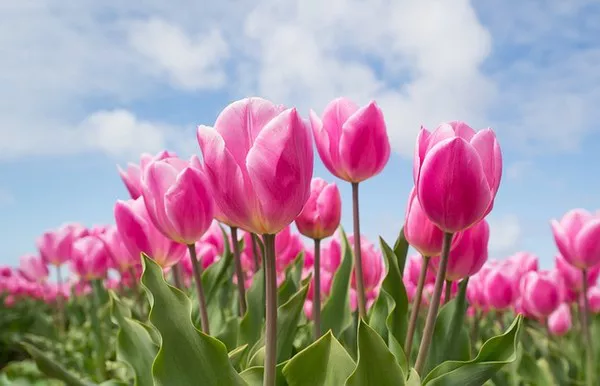In the realm of floral symbolism, few blooms carry as much historical significance, cultural resonance, and sheer aesthetic allure as the tulip. This perennial herbaceous bulbous plant belongs to the genus Tulipa, boasting a stunning array of colors, shapes, and sizes. Originating from Central Asia, the tulip has traversed continents, captivating hearts and minds across civilizations. Beyond its visual appeal, the tulip holds a wealth of symbolic meanings, deeply embedded in art, literature, and folklore. Delving into the intricate tapestry of tulip symbolism unveils a multifaceted narrative that transcends mere botanical appreciation.
Historical Roots: Tracing the Origins of Tulip Symbolism
To comprehend the full spectrum of meanings associated with tulips, one must embark on a journey through history. The tulip’s story begins in the vast steppes of Central Asia, where wild tulips flourished in their natural habitat. Cultivated by ancient civilizations such as the Ottoman Empire and the Persians, tulips gradually gained prominence as symbols of wealth, prosperity, and abundance.
During the Dutch Golden Age in the 17th century, tulip mania swept across the Netherlands, reaching unprecedented heights of economic frenzy. Tulip bulbs became coveted commodities, fetching exorbitant prices and sparking speculative trading. Despite the eventual market crash known as “Tulipomania,” the tulip retained its symbolic value, albeit with a cautionary undertone of impermanence and the perils of unchecked speculation.
Floral Language: Decoding the Symbolism of Tulips
In the lexicon of flowers, each bloom communicates a distinct message, and the tulip is no exception. Its symbolism varies across cultures and contexts, reflecting a rich tapestry of interpretations that transcend geographical boundaries.
In Western culture, tulips often symbolize love, passion, and romance, making them popular choices for declarations of affection and romantic gestures. The vibrant hues of red tulips evoke feelings of deep desire and admiration, while pink tulips convey sentiments of affection and appreciation. White tulips, with their pristine petals, symbolize purity and forgiveness, offering solace and reconciliation in times of discord.
Conversely, in Eastern cultures such as Iran and Turkey, tulips hold deeper mystical connotations, symbolizing divine love, enlightenment, and spiritual growth. In Persian literature, the tulip is revered as a metaphor for beauty and the ephemeral nature of life, capturing the essence of Sufi poetry’s themes of love and longing.
Cultural Significance: Tulips in Art, Literature, and Mythology
The enduring allure of tulips finds expression in various artistic mediums, from classical paintings to contemporary literature. Renowned artists such as Vincent van Gogh and Claude Monet immortalized the splendor of tulips on canvas, capturing their vibrant colors and graceful forms for posterity.
In literature, tulips have inspired poets and writers to weave tales of beauty, longing, and transcendence. William Shakespeare, in his sonnets, employs the tulip as a symbol of fleeting beauty and the passage of time, encapsulating the essence of human mortality in its delicate petals.
Moreover, tulips feature prominently in mythology and folklore, often associated with tales of love, transformation, and rebirth. In Greek mythology, the story of Clytie, who transforms into a tulip after pining for the sun god Apollo, embodies themes of unrequited love and eternal longing.
Modern Interpretations: Tulips in Contemporary Society
In contemporary society, tulips continue to captivate hearts and minds, serving as emblems of hope, resilience, and renewal. Their vibrant blooms herald the arrival of spring, symbolizing the rejuvenation of nature and the promise of new beginnings.
Furthermore, tulips play a significant role in various cultural celebrations and ceremonies, from weddings to religious festivals. Their presence adds a touch of elegance and sophistication to floral arrangements, conveying sentiments of joy, prosperity, and unity.
In the realm of environmental conservation, tulips serve as ambassadors for biodiversity and sustainable gardening practices. As advocates for pollinator-friendly gardening, tulips attract bees and other beneficial insects, fostering ecological balance and preserving fragile ecosystems.
Conclusion
In conclusion, the meaning of the tulip transcends its botanical attributes, encompassing a vast spectrum of cultural, historical, and symbolic significance. From its origins in ancient civilizations to its enduring presence in contemporary society, the tulip continues to inspire awe and fascination, serving as a timeless emblem of beauty, love, and transcendence.
As we gaze upon the delicate petals of the tulip, let us not merely see a flower but a profound symbol of the human experience—fragile yet resilient, ephemeral yet eternal. In its graceful form and vibrant hues, the tulip reminds us of the enduring power of nature’s beauty and the universal language of floral symbolism that transcends time and space.


